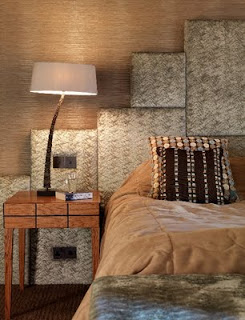MANY master bedrooms are an afterthought. Interior designer Jamie Hempsall explains why they should be the focus of investment in making a relaxing hideaway.
It might not be the area of your home that most visitors see, but it is the one that you visit all the time – so why not lavish a little time and effort on yourself? Families often treat the young to a carefully designed bedroom-cum-playroom, but feel guilty about co-ordinating their own space.
However, by ensuring that you have a safe haven in your own home, you will be enhancing your feelings of ownership and security, which really does then filter into most other aspects of your life.The main priority for a restful night’s sleep is to create an uncluttered environment that reflects your personal taste. This is a place to be selfish – ignore thoughts of others, this is a room devoted entirely to you and your comfort.
The easiest way to create an instantly restful double bedroom is to make it relatively symmetrical – balancing either side of the bedroom so that it is visually comforting. This does not need to be slavish mirroring, but weighted so that furniture of comparable sizes is evenly distributed within your scheme.
Your bedside furniture is important. Matching cabinets on either side of the bed, with plenty of storage for books and all of the other paraphernalia we accumulate, are essential to create a clean and simple sleeping environment. These should be combined with identical (or co-ordinating) lamps of the same shape and height with shades that match. This direct balancing helps to instil a subconscious feeling of calm.
Ensure that you have plenty of cupboard space available to tidy clothes and make all occupants put everything away after use: a neat environment is also important to create a relaxing environment. A good laundry bin with a lid helps deal with discarded clothing at the end of the day and is an easy method of transport to the laundry.
I would strongly advise on keeping your pillowcases, sheets and duvet covers plain to avoid any limitations on future decorating schemes and dress with cushions and covers to add interest.When it comes to flooring, carpets really are king. The soft feel and warmth in the morning under bare foot is difficult to beat. If you already have natural floors then add rugs either side of the bed that are at least three feet wide to soften the look and feel.
Avoid using overly busy designs or really vibrant colours in your fabrics, wall-coverings and soft furnishings. Their impact may well work in the morning, but are unlikely to invoke the calming environment we all need when retiring for forty winks. Sometimes it is all about creating a get-away space and this is what we were asked to do in one of our award winning designs.
Our clients were a busy working couple with a young family who wanted to create a calm and comfortable haven away from the rest of the world once they retired to the bedroom. They loved travel and wanted a boutique hotel feel.
We started by knocking two large rooms together to create an intimate space for them to share together incorporating a flowing set of spaces for sleeping, dressing and bathing.The idea was that the space still gave privacy to each individual (with features such as the curved privacy screens in the bathroom) while allowing them to remain in contact and maximise their limited time together.
The oversized bed was designed to invoke the comfort and safety a child feels when getting into a warm, apparently massive bed and the hidden rise and fall TV in the base plate helped provide a necessary evil without upsetting the sight lines.
Velvets and silks in muted brown and duck egg blue tones provided a soft and sumptuous backs beyond.Natural wood and marble finishes with curved surfaces throughout enhanced the feeling of natural synergy.Sofas were included to allow conversation areas and ease of dressing.
The key to a room such as this is in the lighting. Antiqued mirrors were used throughout to help overcome the poor natural daylight and wallpaper with a subtle repeating fleck was used to invoke an all-day subtle up-light effect.
Accent, sculptural lighting was used to provide strong visual images with subtle dimmable lighting – while wall wash and floor wash lighting was used in the bathroom to allow easy use throughout the night.Bedside remotes control everything electrical in the room for the ultimate feeling of pampered indulgence. It is just a pity we could not arrange room service.
Jamie Hempsall is a member of the British Institute of Interior Design and an award-winning interior designer. Visit him at www.jamiehempsall.com or contact him on 0800 032 1180
This article was originally published in the Yorkshire Post Saturday Magazine on 19th June 2011















